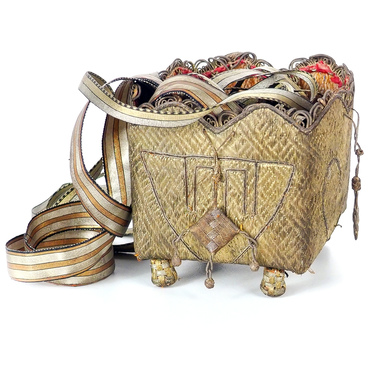The traditional festive attire of Circassian women looked grand and stately.
The Adyghe Women’s Traditional Costume
Время создания
Late 19th-early 20th century
Техника
Velvet, silk, silver lace, brocade thread. Local embroidery technique: ‘адыгэ дышъэ идагъ’
27
Открыть в приложении#1
The Adyghe Women’s Traditional Costume
#11
#3
Its base was “sai”: an unbuttoned floor-length gown of velvet or rich silk. The sai was richly decorated with gold and silver embroidery and laces (gold embroidered ribbons), or with precious metal trimming. The edges, borders and cuffs were ornamented with patterns, and all the stitches were covered with gold and silver laces. Usually, such gowns were dark-red, rarely they could be blue, dark-green and violet.
#14
The exhibited 'sai is decorated by the method of Adyghe embroidery (“адыгэ идагъ”). The patterns are embroidered with golden threads, which is indicative of high culture of Adyghe craftsmanship. Moreover, craftsmen of the past centuries decorated vestments with appliqued ornaments of silver foil and leather.
#4
Adyghe girls used to wear the sai over a long silk robe and on top of a short frock. The top of the frock was decorated with silver buckles, and the bottom, to be seen between the spreading flaps, with embroidery or gold and silver laces.
Closer to the end of the 19th century the frock was replaced with a thick chest vest imitating the frock. It was sewn with around 16 pairs of buckles with cast silver hooks going from the stand-up collar down to the waist. They could be fastened only by tightening up the vest, due to which it tightly fit with the body.
#7
Originally, the sleeves of the traditional gown were cut either shoulder-high of elbow-high, and they hang loose to cover the hands. Later, another type of the sleeve appeared: it started just under the shoulder and gradually evolved into a round blade that could reach the gown border. By late 19th century such decorated blades had become a separate element of the costume: sleeve pendants (“Iашъхьа бэлагъ”).
#8
Nonetheless, whatever sleeve version was selected by the needlewoman for the gown, the girl’s arms never remained bare above the elbow: they were covered with a frock or an undershirt.
#9
The sai was usually belted. The buckled belt of the exhibited gown was made of sterling silver. Such belts were designed for girls and young women and were called ‘the braided belt’ (‘бгырыпх бгъундж’).
An important element of the women’s festive costume was a traditional cap. The cap could be high or low, but in any case, it was embroidered and decorated with a silver crest, or covered with a broad lace. A canonical supplement to the cap was a scarf or a shawl.
#10
The costume was completed with elegant red or black shoes.
читать дальшескрыть
00:00
00:00
1x
The Adyghe Women’s Traditional Costume
Время создания
Late 19th-early 20th century
Техника
Velvet, silk, silver lace, brocade thread. Local embroidery technique: ‘адыгэ дышъэ идагъ’
27
Открыть в приложении
Поделиться



